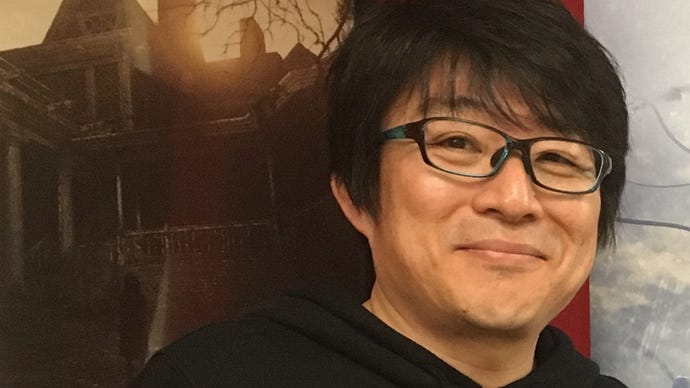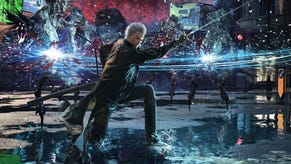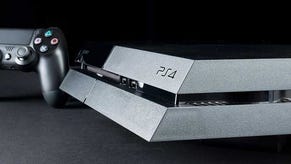"I Thought V Would Be Much More Divisive:" Hideaki Itsuno on the Making of Devil May Cry 5 and Its Success
We catch up with the director of Devil May Cry 5 to talk about its sales success, the positive reception afforded V, and more.
This article first appeared on USgamer, a partner publication of VG247. Some content, such as this article, has been migrated to VG247 for posterity after USgamer's closure - but it has not been edited or further vetted by the VG247 team.
A few blocks from the bustle of the GDC 2019 showfloor, Devil May Cry 5 director Hideaki Itsuno sits beaming in a Capcom USA conference room. Behind him is a plaque commemorating the original Resident Evil 2's sales, a reminder of Capcom's past glories. Those days no longer feel quite so removed from the present, thanks in no small part to Devil May Cry 5 selling two million units in two weeks.
Itsuno chalks up the success to a relatively simple strategy shift. "About three or four years ago, there was a shift where it wasn't so much about focusing on what the market wanted," he says. "It was more of a shift of, 'Let's make what we want to make, and what we consider to be the highest quality and the best game.' Three or four years later, which is now, is when you're starting to finally see those games come out. It's nice to see that success."
Devil May Cry 5 is perhaps the clearest evidence of that shift. Monster Hunter: World is easy to pitch as an online service game, and Resident Evil is still a major franchise, but Devil May Cry is a slightly tougher sell. As an old school single-player action game, some thought the franchise might be done after the westernized update of DmC: Devil May Cry failed to meet its initial sales targets. But after the success of Devil May Cry 5, the franchise's stock is once again on the rise.
"I definitely feel like there has been a shift where there is a larger voice [within Capcom] that's like, 'Oh, hey, there's potential in this franchise.' Like, 'Oh, he can just keep making more Devil May Cry games.' There is definitely more of that sentiment," Itsuno says. "That sentiment has never gone away from me, personally. I wanted to make Devil May Cry 5 immediately after making DMC 4. It is interesting to kind of see what I have felt for so long permeate through the larger company."
In the wake of Devil May Cry 5's success, I sat down with Itsuno to talk about its reception, the creation of V, and the challenge of building an action game around three distinct characters. I also asked some spoiler-filled questions, which you can find after the warning below. Here's what Itsuno has to say about the making of Devil May Cry 5.
USG: Going into the release of Devil May Cry 5, I'm curious, what was your confidence level? Especially given that it was a little bit of a risky project?
Hideaki Itsuno: In the very beginning, I was quite confident. The reason being was I felt... Well, the first target audience was the Devil May 4 players. I wanted to make sure that any and all people who played and enjoyed Devil May Cry 4 would buy this new title. That was kind of how the original forecast was set. I was very confident that we would be able to hit that, so I wasn't too worried.
Somewhere down the line, we did some focus testing and we realized, "Hey, this title is actually getting some positive reception from players who are in their teens," and realizing, "Oh, this is something that we could cater to brand new players." We decided to make some tweaks and make sure to be conscious of the fact that, hey, we also want to expand our audience.
When the target started to shift to that, that's when my confidence started to wane a little bit. I was like, "I'm not too sure I'm doing this properly," especially with things like the visuals changing a lot as well. I wasn't too worried about the North American audience, but there was definitely the perception that the Japanese audience might not like the shift away from anime. Maybe they want to kind of have that same anime look, but seeing all the positive reception during the E3 announcement kind of re-instilled that confidence back in me that was like, "Okay, I'm making the right moves here. This feels good."
V has gotten a very good reception as well. You must feel kind of gratified because he's a new character. You never know how people are going to like a new character, especially with a really radically different playstyle. Tell me about how you're feeling about that.
I'll be honest, I was actually very surprised by the positive reception. When we created the character, I thought V would be much more divisive, where I thought people would either really like him, or be very lukewarm about him. From what I've seen, everyone's actually been very welcoming of his addition, which has been really great. I think it's because I made him quite powerful. I have a rule that when you introduce a new character, you need to make them very formidable.
I think that's part of the reason why he was received so well. In terms of comparing him between Nero and Dante, I felt like we didn't expand his gameplay nearly as much as Nero and Dante. You actually see him appear in fewer stages, just to kind of balance that out. I think that level of tuning also added to the satisfaction of his gameplay component. All in all, I was surprised, but still very happy that he was received so well.

Creating three different distinct styles of play with three characters is challenging. Tell me a bit about how you overcame those challenges, and how you feel about the final result.
I had assumed the average player wouldn't just be satisfied with one playthrough, that they would want to try to play it at least twice. We kind of designed with that in mind, with maybe some hardcore players playing it three or more times. That was the general sense of the way we balanced it. That component wasn't too bad.
In terms of the combat, yes, you have three very distinct characters, but we purposely made sure that the functions of the controls were all very similar. For example, if you wanted to make a close ranged melee attack, that would be the same button input. We were very calculated in making sure that even if the way you think and the way you approach playing a character is different, the controls would at least stay consistent. Those were the aspects that I made sure we fine-tuned so that it was a satisfying experience for the players.
In terms of the final production and how I feel about it, I think it turned out very well. The one thing that I feel like could've been changed is maybe Dante could have appeared a little bit earlier. I feel like we kind of stretched it out just a little bit too much, and it might've been better to bring him forward earlier.
Ultimately, what do you think was the biggest success in Devil May Cry 5?
I wanted to make people cry after Mission 20. On top of the complex gameplay and the narrative, I wanted to just build the entire structure in a way that the player would experience things that would all lead up to Mission 20 where they would just be filled with emotion. Having read a lot of comments online and watching some YouTube reactions of like, "Hey, I just completed the game. I just cleared Mission 20 and I'm crying." It's cool to see that kind of feedback and know that I was able to accomplish what I had set out to do. That was a great success.

Spoiler Alert! This is where we talk with Itsuno about the end of Devil May Cry 5. You have been warned!
Tell me a little bit about bringing back Vergil and designing that final encounter in a way that could be satisfying to longtime Devil May Cry fans.
One of my main objectives was to have an adversary that would make both Dante and Nero take things as seriously as possible, and would put them in a situation emotionally that they would be really invested in. I wanted to make sure they would put their life on the line to overcome it. When we're thinking about that kind of situation, there just wasn't anyone that could surpass Vergil. Vergil was the epitome of the perfect adversary for them.
We were thinking, "Okay, well, what if this random demon king popped up, and we said in the narrative that he's the strongest in the world?" From a user perspective, I suppose it's like, "Really? Is this something I'm supposed to believe?" From a play perspective, I felt that was something that would be very difficult to digest, this random adversary that had never made an appearance before becoming the main villain. I just felt like you couldn't have an emotionally-driven story without the presence of Vergil.
Were there any plans to give Trish and Lady more of the spotlight in Devil May Cry 5?
I think there's a time and place for everything. For Trish and Lady, Devil May Cry 4 Special Edition was their moment to shine, and that was where the spotlight was placed on them. For Devil May Cry 5, I felt like the focus of the narrative and the game was very much the playable characters, and that was Nero, Dante, and V. All of the characters making an appearance in Devil May Cry 5 were very much designed to shine a spotlight on those three characters. That's kind of the way that we constructed the narrative this time around.
Long story short, I needed more money. The main point that I wanted to focus was on the fall and rise of those three characters, and all my money was poured into that.
This interview has been edited and condensed for clarity.















